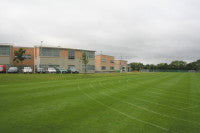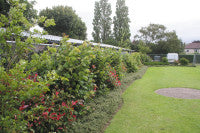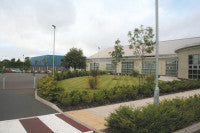Walsall Academy
 It is a phrase that has passed the lips of countless Britons of eras past and present that appearances can all too often be notoriously deceptive. Following the two or three minutes that a standard visitor has to familiarise themselves with the less than attractive Walsall suburb of Bloxwich, the moment when the town's freshly completed city academy looms into view serves to compound this idea in my case.
It is a phrase that has passed the lips of countless Britons of eras past and present that appearances can all too often be notoriously deceptive. Following the two or three minutes that a standard visitor has to familiarise themselves with the less than attractive Walsall suburb of Bloxwich, the moment when the town's freshly completed city academy looms into view serves to compound this idea in my case.
With the design of the building offering numerous clashing combinations of slanted steel rafters and sweeping curves, it is difficult to believe that any humble classroom environment could possibly be housed within such an invigorating outer shell. Even more difficult, perhaps, to believe that the time and effort invested in creating such a radical feat of architecture could possibly leave any room for thought regarding the upkeep and maintenance of the school's expansive grounds.
However, James Broadhurst sees no truth in such assumptions. A man whose past occupations include seven years spent maintaining the grounds of the National Sports Centre at Lilleshall, followed by a further three at the RAF's training facility in Cosford, his appetite for a fresh challenge saw him join the academy as Head Groundsman in July 2003, two months prior to the facility officially opening its doors to 500 students of ages 11-18 years.
The academy's two-pronged grounds maintenance force was completed in April 2004 by the arrival of assistant, and former butcher, Mark Langston, and the duo have long become an institution of the school environment as the academy has negotiated its way through its early years.
With an endearing combination of outdoor sports facilities and decorative foliage occupying two of the three hectares spanned by the entire complex, James has always had his work cut out in elevating the school grounds to a level of quality that truly sits on a par with the aesthetic and calibre of the building itself.
Required to sustain the quality and integrity of the school's diverse sporting amenities (consisting primarily of three grass sports pitches offering a wide range of uses, supplemented by four tarmac tennis courts and three netball courts), James also takes responsibility for the maintenance and remedial duties concerning the numerous shrub beds and ornamental lawns that represent a substantial element of the academy's visual demeanour.
With the changing functions of the different pitches combining with an unrelenting tirade of use by four groups at a time, three consecutive days weekly, it is little wonder that the strains placed upon the groundskeeping duo equates to a working week often totalling in excess of 80 hours.
It was made clear to James from the outset that the site of the academy also posed its own unique array of dilemmas and pitfalls, throwing down the gauntlet in administering the sternest of tests to his groundskeeping skills.
P resented with an uncompromising soil rife with stones and a multitude of fine sands, the academy's location on a brownfield site resulted in the unwelcome inheritance of an array of crests and dips that characterised the grounds of the old TP Riley school. Completing this throng of predicaments has been the continual problem of foxes, whose holes have persisted in plaguing most of the work undertaken by the duo throughout their time at the academy.
resented with an uncompromising soil rife with stones and a multitude of fine sands, the academy's location on a brownfield site resulted in the unwelcome inheritance of an array of crests and dips that characterised the grounds of the old TP Riley school. Completing this throng of predicaments has been the continual problem of foxes, whose holes have persisted in plaguing most of the work undertaken by the duo throughout their time at the academy.
However, both first impressions and closer inspection of the grounds suggest that they have fared remarkably well in repressing the site's fundamental physical problems, having been fortunate enough to encourage exceptional grass growth in both stature and allure. With the pristine conditions extending to encompass all of the area surveyed, one can ultimately conclude that the high quality boils down to the methods that James has developed.
Mowing is undertaken two or three times over the course of a week, a task that usually requires the best part of a day to complete. With no fewer than five different mowers at his disposal, James is blessed with the necessary tools of the trade, opting for a cutting height of 22mm in summer that rises to 27mm as the rugby pitch (whose existence spans the months of November-February) takes shape.
As well as the weekly marking out of the pitches (the 200m six lane athletics track of the summer months can be completed within a day), James also invests arresting levels of pride into his work, regularly conducting soil tests to ensure that maximum levels of quality can be extracted from a fundamentally hostile surface.
End of season renovations centre around the application of 120 tonnes of sand onto the school's playing surfaces, serving to aid the drainage of an area of rather questionable efficiency in this department (indeed, the standing water stemming from the recent heavy rain at one point reached the half-way line of the main football pitch). To supplement this, sward quality is improved when the pitches are scarified, vertidrained, overseeded and fertilised, while any litter (a problem that comes in phases, according to James) is also removed from the grounds.
However, this endeavour alone has not resulted in the grounds adopting such an impressive appearance; it is the effort of James that has been the driving force in reforming the character of the area. Working in collaboration with the PE staff at the school, he has strived to remove the more notorious of the lumps and bumps that initially served to hinder the quality of the site's two football pitches, while two hours has been spared each week in order to remove the most conspicuous of the soil's stones to improve the general safety of the surfaces as much as possible.
Along with this, James has toiled continually to maximise the visual qualities offered by the site's numerous shrub beds and ornamental lawns. Ripping out many of the site's original attempts at decorative foliage, he has given many an hour to the cause of nurturing much of the new plant life (most of which was planted in the latter half of 2003, including many trees and plants to mask the damage present on the fences aligning the academy site), which has produced results bordering on the prodigious.
This has served to add a welcome natural vigour to the area surrounding the central academy building and, having been fortuitous enough to have examined pictures of the site immediately after the construction of the academy, it is credit to the skills of Mark and James that such a seamless sense of harmony between modern architecture and natural vegetation has been achieved.
Always in pursuit of a fresh challenge, however, James is still not entirely satisfied with the overall condition of the grounds at Walsall academy. He has long set his sights upon elevating the pitches to a level complicit with the National Performance Quality Standards, intending to do this by further levelling out of the surfaces to the point where they are completely flat.
However, he nonetheless acknowledges that his work thus far has been profoundly beneficial for all those associated with the school, and believes that he is now fortunate enough to have a greater capacity to look for further improvements around the site having got on top of just about everything associated with the area.
Having laid down such watertight foundations for these enhancements to be built upon, one can only imagine the sheer quality of surfaces that will emanate following further renovations. However, with a man as zealous as James Broadhurst calling the shots, it can be confidently ascertained that Walsall academy will only continue to thrive in the foreseeable future.
